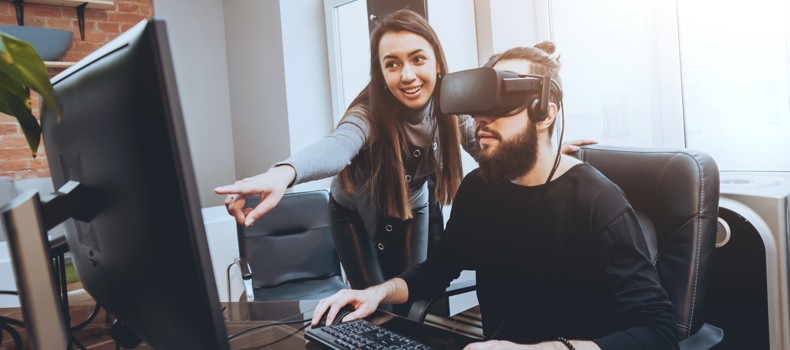 1-800-805-5783
1-800-805-5783 
Virtual Reality in Interior Design Industry involves close collaboration with a designer to understand the need of a customer for designing an aesthetically pleasing and functional space. Interior designing is typically seen as a time-consuming and costly process that is fraught with communication challenges. Customers at times find it difficult to define their need through verbal communication or using sketches, models, mock-up, etc. VR technology makes it easier to communicate and visualise by focusing on the rich immersive experience for a better realisation. Here is how Virtual Reality can change Interior Design in important ways:
1. Dynamic Design Visualisation
Dynamic real-time visualisations are possible using game engines to create a realistic environment of interiors. The design emerges keeping in mind interior structures, materials, spatial planning, and ergonomics, allows the user to move around freely and conceptualise a layout of their own choice. Being inside the space creates a unique perspective and makes customers appreciate the efficient ways of how the design works out. Specific VR devices and HMD’s like Oculus Rift, HTC Vive, Google Cardboard, and Samsung Gear VR, when used in combination have the ability to turn mobile devices into VR devices and allow customers to experience a virtually decorated output.
2. Help Interior Designers with a Customer-Centric Approach
VR helps interior designers to be a lot more sympathetic by understanding the necessity of the client and create an effective design. Using a customer-centric design approach allows interior designers to fulfil the aspirations of a customer. Thrilled with the virtual experience customers can see how the pieces go together, eventually turning into reality, which exudes confidence in their decisions and creates deeper associations. With increasing cost-effectiveness of virtual visualisations, it is now easier for the interior designers to engage interact and bring in greater precision to design which is affordable and customer friendly.
Sales of VR/AR headsets forecasted to be about 9.7 billion by the year 2020. Share on X3. VR Catalogs and Customer Engagement
Engaging the customer using VR catalogs allows them to see designs from the comfort of their living rooms. These types of experiences foster greater engagement with customers and increase brand loyalty. According to Statista IKEA uses the concept of virtual catalogs and have been able to increase their sales from 27.6% in 2012 to 35.1% by 2016.
42% of respondents find the design and information of furniture to be insufficient, a major factor for indecision. Share on X4. Reduce Business Operational Cost
It is important for businesses to monitor their bottom line and for ways to improve profit margins or reduce cost. VR is changing business- by streamlining processes, cutting man-hours spent on training, interviewing, reducing travel, meetings, helping to promote e-advertising, and accelerated design prototyping when compared to the traditional methods. As VR enables the focus towards revenue generation, the future indicates numerous possibilities for the interior design industry to adapt and deliver.
5. Tapping into New Market Avenues
The next step is to create VR ads owing to a shift in digital ads compared to the ones shown on TV. The idea is to create ads and content which will be displayed using mobile apps. YouTube is already working towards generating VR marketing options. Fostering user engagement to demonstrate the attributes and features, VR is adding a whole new dimension to traditional storytelling. A study by Nielsen indicates that VR has a 17% higher emotional response than a 360 video, and engaged users for 16% longer as it provided an immersive branded experience.
Like moving pictures at one point, and like photography before then, VR is an entirely new method of visualising things. Such radically new tools, as we know, invariably lead to new ways of communication, new ways of working, and new art forms. Although still nascent, VR is an empowering technology that facilitates improved communication and design through sophisticated visualisation techniques. The [x]cube LABS team is passionate about the potential of VR in the interior design space and has deployed solutions in VR for enterprises globally. To explore how Virtual Reality helps the design industry to transform itself, connect with us to know more.
Tags: Virtual, Virtual Reality